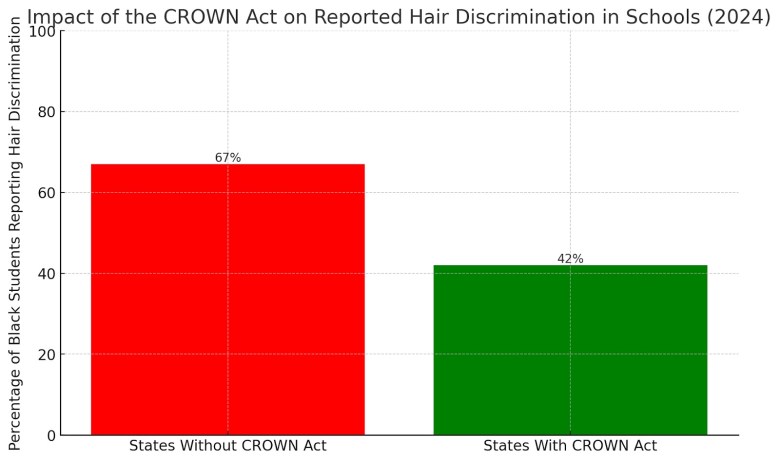By Quintessa Williams
The CROWN Act on a federal level is a hot topic of discussion for members of the Democratic party. After recent shows of natural styles at the DNC, there is now talk of the federal government following a popular law that has now been adopted by 25 states.
(Photo: Nappy.co/ Jason1)
During the Democratic National Convention, Michelle Obama’s stunning braids and Tennessee Rep. Justin Pearson’s mighty afro were celebrated nationwide as symbols of Black pride, cultural identity and resistance.
Given that the former First Lady once said America wasn’t ready to see a Black woman with anything but straight hair in the White House, their hairstyles symbolize a growing acceptance and recognition of natural hair in political spaces.
However, while Black hairstyles are becoming more accepted in politics, a stark contrast exists in America’s public schools. Black hair may be embraced in some spaces, but it remains heavily policed and criminalized in classrooms.
Hair dress code policies in schools disproportionately affect Black students, leading to higher rates of negative perceptions about their identity, severe psychological effects and students being shoved into the school-to-prison pipeline.
Just weeks before the DNC, a judge dismissed a racial discrimination lawsuit filed by Darryl George, a Black student in Texas, after it was ruled that he was lawfully punished for wearing locs, a hairstyle rooted in African culture and spirituality. The school cited ‘”its dress code”’ as the reason for the suspension.
A national issue for Black students
Savannah Walker, an Andrew Jackson High School senior in Jacksonville, Fla., tells Word In Black that when schools enforce such policies, they are “not only policing hair but identity as well.”
“They’re basically telling us that we as our natural selves are unacceptable and that we must conform to White norms to be seen as respectable and worthy. This is hurtful, especially for young people like me who are still figuring out their sense of self and identity.”
In 2017, 17-year-old Jenesis Johnson was sent to in-school suspension for wearing her natural afro to school. The school’s dress code mandated that hair be “kept neat and out of the face,” and administrators claimed her afro was a distraction.
A year later in 2018, Faith Fennidy, an 11-year-old from Louisiana, was sent home because her braided hairstyle allegedly violated the school’s dress code. Fennidy’s case garnered national attention and sparked outrage over discriminatory hair policies in schools.
 Students across the country are feeling the impact of the CROWN Act, which addresses
Students across the country are feeling the impact of the CROWN Act, which addresses
hair discrimination in schools and the workplace. Shown here, a visual explanation of
the amount of students who report hair discrimination in states with and without the
Legislation. (Photo courtesy of Word In Black)
In 2019, Tyler House, a high school wrestler in Kentucky, was forced to cut his locs on the spot or forfeit his match. The referee insisted that his locs were not compliant with the sport’s regulations despite other athletes with similar hairstyles not being asked to make changes.
These incidents, and many others like them, highlight the ongoing struggle Black students face in schools across the country.
According to a 2020 report from the American Civil Liberties Union (ACLU), Black students, who make up only 15 percent of the U.S. public school student population, account for 45 percent of all school suspensions related to hair being cited as a dress code violation. In addition, 25 percent of Black students reported being penalized for wearing their natural hair, compared to just 5 percent of White students.
Does the CROWN Act protect Black students?
As of 2024, 25 states have passed the CROWN Act (Creating a Respectful and Open World for Natural Hair), which protects against hair-based discrimination in workplaces and schools.

The act first became law in California in 2019 and is designed to ban discrimination based on hair texture and protective hairstyles, including locs, braids, twists, and afros. In March 2022, the U.S. House of Representatives passed the federal version of the CROWN Act. The Biden Administration voiced its support for the legislation. However, the bill stalled in the Senate, leaving millions nationwide without protection against hair-based discrimination.
In states without the CROWN Act, 67 percent of Black students report experiencing discrimination or bias related to their natural hair in school. However, states with the CROWN Act have seen a 25 percent decrease in reported incidents of hair discrimination.
Where do we go from here?
In May 2024, Democrats reintroduced the CROWN Act at the federal level. New Jersey Sen. Cory Booker, a leading voice in the fight for the CROWN Act, said, “This is not a partisan issue. The federal government would simply be following the lead of our states. This is an issue of justice. This is an issue of fairness. This isn’t just an issue of ending discrimination that has existed for too long. Enough is enough.”
Meanwhile, in Jacksonville, Savannah Walker’s father, Kadeem Walker, says he believes a potential federal ban on discrimination against Black hair will ensure all students are free to express their cultural hair identity without fear of punishment.
“We must implement federal protections like the CROWN Act and hold schools accountable for discriminatory dress code policies,” he says. “It will be a giant step in ending these discriminatory practices on natural hair across the nation.”
This article was originally published by Word in Black.



